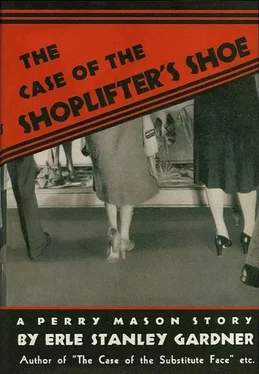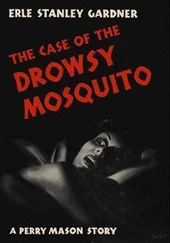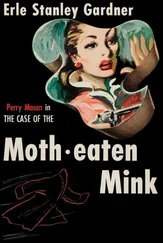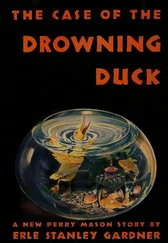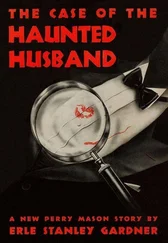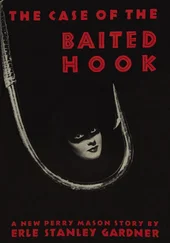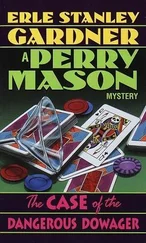He heard Mason saying, “Now, if the Court please, having demonstrated that George Trent could not have been killed with the so-called Trent gun, he must have been killed by the Cullens gun, since it is established beyond question that there are only two guns, the Trent gun and the Cullens gun, and only two fatal bullets, the Trent bullet and the Cullens bullet. The bullet taken from Trent’s body matched the test bullet fired from one of the guns in the possession of the ballistics department. Since that couldn’t have been the bullet fired from the Trent gun, it must have been the bullet fired from the Breel gun.”
“Now then, your Honor, in view of the circumstances, I now ask that the jury be permitted to go to the house of Austin Cullens for the purpose of viewing the premises.”
Sampson’s only instinct was to fight. He jumped to his feet and said, “For what purpose, your Honor? Surely, nothing can be gained by having the jurors make such an inspection.”
“What is there there you don’t want them to see?” Mason asked.
“Nothing.” Sampson said lamely.
“Then why not let them go?”
Judge Barnes took a hand. “Just a moment, Mr. Mason,” he said, “you will please refrain from arguing with counsel, and address yourself to the Court. Just what reason have you for asking that the jurors go to these premises?”
“Simply this,” Mason said “the gun, which the witness Diggers says was found in the Breel handbag, actually came from the hip pocket of Austin Cullens. You will note, from Sergeant Holcomb’s testimony, that there was nothing whatever in the right-hand hip Pocket of Austin Cullens’ trousers. The reason there was nothing there is that Cullens was in the habit of carrying a gun there. In that Pocket, he carried a gun which killed George Trent. That is the gun which the witness Diggers claims was found in the handbag of the defendant in this case. Now then, your Honor, note the significant portion of the testimony given by the witnesses, Golding and Tannis. They, both of them, state there were two shots. The testimony of the autopsy surgeon is that there was only one bullet found in the body of Austin Cullens. There has been no explanation of what gun fired the other shot. Under the circumstances, the defendant feels that the jury should be given an opportunity to view the premises for themselves, and, if they desire, make some investigation to find out if there’s another bullet...”
Judge Barnes shook his head. “I don’t think that it’s a fair interpretation of the privilege of viewing premises to make the jurors witnesses to the discovery of some fact which may have a vital bearing on the case. However, the Court will appoint a disinterested investigator to make such a search if Counsel so desires, and that investigator can be accompanied by Counsel for both sides, and report to the Court in the morning.”
“That is quite satisfactory to me,” Mason said, “and in order to show that my desire is only to establish pertinent facts, I will suggest that the Court appoint Carl Ernest Hogan, the ballistics expert of the police department, to make this investigation forthwith in the presence of Mr. Sampson from the district attorney’s office, and myself as the representative of Sarah Breel.”
Judge Barnes nodded. “It is so ordered,” he said, “and Court will adjourn until tomorrow morning at ten o’clock.”
An uproar gripped the courtroom.
All the way out to Cullens’ residence, Larry Sampson maintained a thoughtful silence. Gradually, he commenced to pick up the loose threads of various ideas which had been flitting through his head and weave them into a comprehensive pattern. Hogan also was silent, the careful silence of one who is afraid to say anything lest he say too much. Perry Mason, on the other hand, was filled with conversation, but his conversation had nothing to do with the case of the People vs. Sarah Breel. Instead, he told stories, discussed politics, and in general, kept up such a constant flow of words that the others were interrupted in their attempts to center their minds on the problem which had assumed a position of such importance.
Behind the official car containing the lawyers and the man appointed by the Court to make the official inspection, there came a police car and three automobiles filled with newspaper reporters and photographers. Sampson turned uneasily in the seat to frown at the glaring headlights which poured in through the back window. “Look here,” he said, “we don’t want all of this bunch in there tramping around.”
“Why not?” Mason asked.
“They might interfere with our finding evidence. And besides, the Court said that only the three of us were to go in.”
“Oh, no,” Mason said affably, “the Court remarked that Hogan was to be the Court’s disinterested viewer. We were permitted to accompany him to see fair play. Nothing was said about the others.”
“Well, I don’t want them in there.”
“All right,” Mason said, laughing, “you take the responsibility of keeping them out — you know how the newspaper reporters will feel about that.”
“Why don’t you keep them out?” Sampson asked. “You know, I’m holding a political office. I can’t very well antagonize the press.”
“I’d just as soon have them in,” Mason said.
And so it was that as Hogan entered the room where the body of Austin Cullens had been found, newspaper reporters crowded in the hallway. Photographers snapped pictures as flash bulbs exploded, and those photographs, subsequently published in the morning papers, showed Perry Mason smiling, affable, good-natured, while the deputy district attorney’s expression showed only too plainly the worry which was gnawing away the last underpinning of his self-possession.
Hogan went about his business with calm efficiency. “The body,” he said, “as I understand it, was lying about here. Now, it’s your contention, Mason, that this bullet had been fired by Cullens from a gun which he took from his pocket. Therefore, Cullens must have been facing in approximately this direction when he was killed. The bullet might be anywhere from the level of the floor to a point, say, six feet from the floor level... I see no evidence of any such bullet.”
“Well, let’s keep looking,” Mason said. “I feel the gun must have been discharged about as I pointed out. It’s the only logical explanation which accounts for the facts. However, it’s certain the bullet hole isn’t where it could be readily detected or it would have been seen... What’s this in the chair?”
Hogan dropped to his knees to inspect an opening between the arm of a leather-upholstered chair and the seat cover. On the under side of the seat was a peculiar rip, the edges stained with black.
“That,” Hogan said, “ might be something.”
“Pull the seat out and take a look,” Mason said.
Hogan pulled out the seat. Back of it, and in such a position that it had been concealed by the seat cushion, was a small, round hole. Hogan looked at the back of the chair. There was no hole in the back of the chair.
“If that’s a bullet,” Mason said cheerfully, “and it looks like a bullet, it’s still in the chair. Suppose we find out.”
Hogan said, “I think we’d better have some photographs of this before we go any farther.”
Newspaper photographers were only too willing to oblige. They pushed forward and shot a dozen pictures.
Hogan opened a sharp-bladed knife, took a pair of long-nosed pliers from his pocket and said, “Here we go.”
He cut back the upholstery of the chair, pulled out some hair stuffing. A bullet was embedded in the oak frame of the chair. “How about it,” Hogan asked Sampson, “do I dig this bullet out?”
Читать дальше
